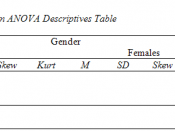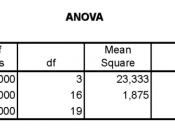OBJECT RECOGNITION
RESULTS
Three sets of data were examined to discover whether there were significant effects from any of the factors. The accuracy data measured the percentage of correct responses when detecting the target object. The reaction time data measured the mean response time for the correct responses only. The last set of data were the D-prime data; D-prime indicated the subjects' accuracy towards a particular target, accounts for the responses on the present and absent trials to take into account bias, the larger the D-prime value, the better the subjects was at detecting the target object. The total number of subjects was reasonable large, therefore the statistics obtained should be reliable.
For the accuracy data, the grand mean indicated that there were over 70% correct on all trials (73.87%). The response means showed a significant difference between present trial (70.467%) and absent trial (77.28%); subjects were more accurate when the target object is absent than present.
Figure 1 showed the estimated marginal mean of percentage correct for the two responses for each category. A two-way analysis of variance (ANOVA) was conducted with "response" and "category of the distracted stimuli" as factors. The ANOVA revealed significant main effect on response (F1,169 = 34.80, p<0.001). This indicated that the response given by subjects might not be independent form the category of the distracted stimuli presented. According to Figure 1, when the distracter were dogs, subjects have bias to give yes as response, whereas for birds, subjects have bias to give no as response, there were no obvious bias when the distracter were ungulates. The ANOVA also revealed significant effect on category (F2,338 = 329.00, p<0.001). The mean of response for different category were not the same. Subjects' response were most accurate when the distracter were birds (78.00%), followed by...


